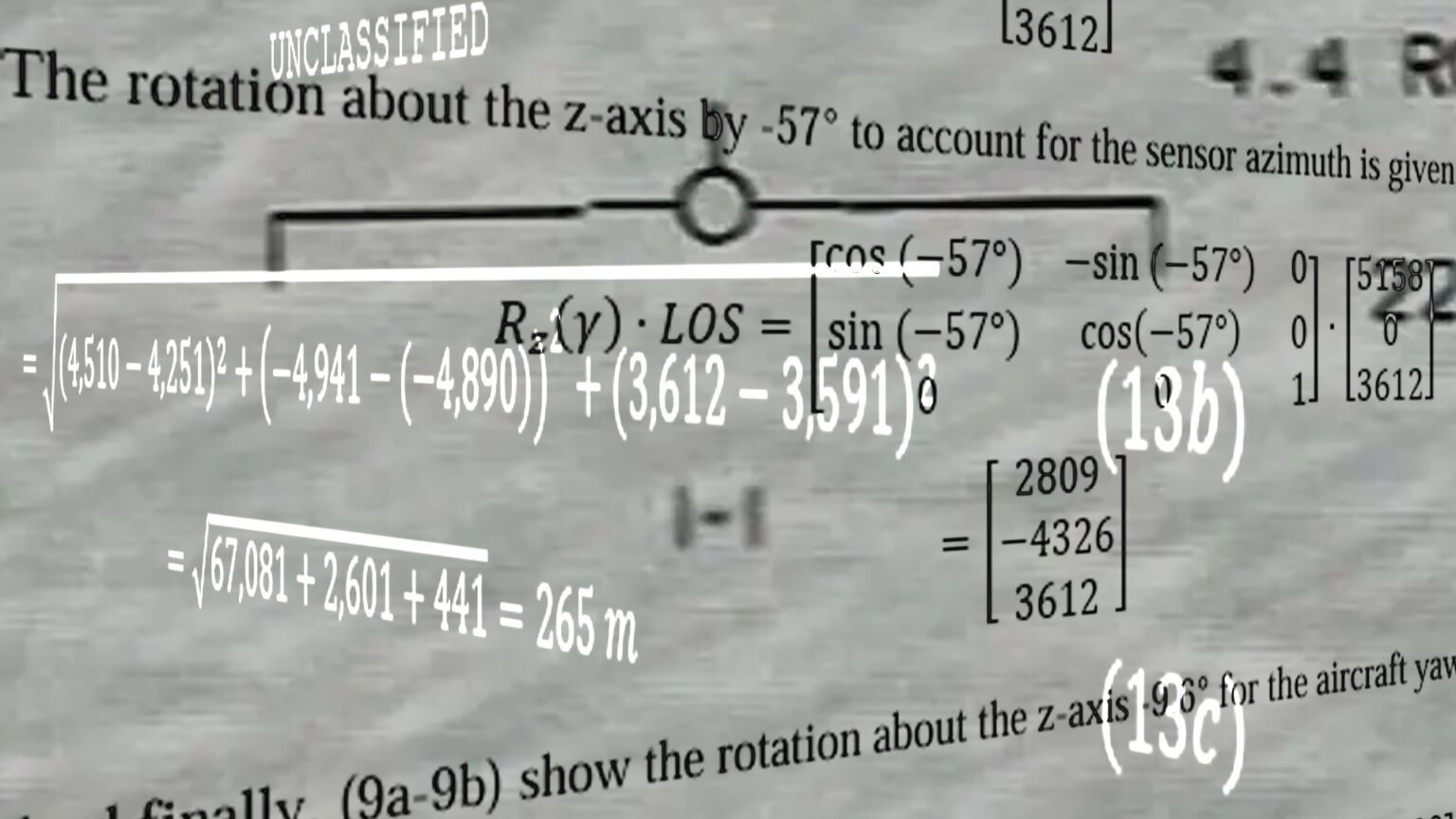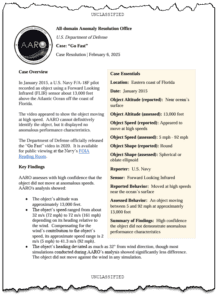 The Department of Defense’s All-domain Anomaly Resolution Office (AARO) has released a new report analyzing the well-known “Go Fast” video, which first appeared publicly in 2018. The report, dated February 6, 2025, provides an in-depth assessment of the unidentified object captured in the 2015 video and concludes that the object exhibited no anomalous flight characteristics.
The Department of Defense’s All-domain Anomaly Resolution Office (AARO) has released a new report analyzing the well-known “Go Fast” video, which first appeared publicly in 2018. The report, dated February 6, 2025, provides an in-depth assessment of the unidentified object captured in the 2015 video and concludes that the object exhibited no anomalous flight characteristics.
The “Go Fast” video was originally recorded by a U.S. Navy F/A-18F Super Hornet off the coast of Florida in January 2015. The footage, taken using the jet’s Forward Looking Infrared (FLIR) sensor, appeared to show a small, fast-moving object traveling just above the ocean’s surface. When the Department of Defense officially released the video in 2020, it quickly became one of three widely publicized UAP videos that fueled public and congressional interest in military encounters with unidentified aerial phenomena.
According to AARO’s report, which is based on a technical analysis of the available footage, the object’s actual altitude was approximately 13,000 feet rather than near the ocean’s surface as originally assumed. The report also estimates the object’s speed to be between 5 mph and 92 mph, depending on wind conditions, with AARO asserting that it was “moving with the wind” and displayed no indications of propulsion or maneuverability inconsistent with atmospheric phenomena.
“AARO assesses with high confidence that the object did not move at anomalous speeds,” the report states. “The object’s apparent high speed is attributable to motion parallax, an optical effect that induces an observer to perceive that a stationary or slow-moving object is moving much faster than its actual speed when viewed from a moving frame of reference.”
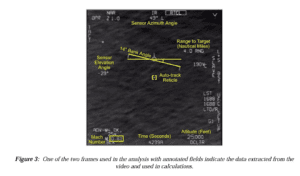 Motion parallax is a well-documented phenomenon that can cause misinterpretations of aerial footage, particularly when captured from fast-moving military aircraft. The AARO analysis incorporated historical wind data from the time and location of the encounter, showing that at 13,000 feet, winds were blowing at approximately 69 mph from the west. Their assessment found that the object’s speed, when adjusted for wind influence, was within a range consistent with that of a small airborne object such as a balloon or drone.
Motion parallax is a well-documented phenomenon that can cause misinterpretations of aerial footage, particularly when captured from fast-moving military aircraft. The AARO analysis incorporated historical wind data from the time and location of the encounter, showing that at 13,000 feet, winds were blowing at approximately 69 mph from the west. Their assessment found that the object’s speed, when adjusted for wind influence, was within a range consistent with that of a small airborne object such as a balloon or drone.
AARO also addressed data limitations in the report, noting that the analysis relied on a compressed version of the video due to the loss of the original file and metadata. Without complete flight telemetry from the F/A-18F, AARO had to account for a range of possible aircraft headings in its calculations. Despite these constraints, the agency maintains confidence in its assessment that the object did not demonstrate any extraordinary flight capabilities.
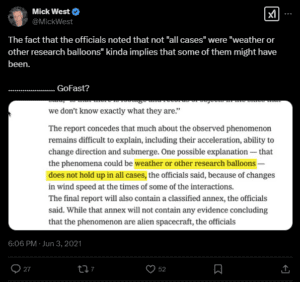 The release of the AARO report has sparked a range of reactions from those who have followed the case. Skeptics of the extraterrestrial hypothesis have pointed to the findings as further evidence that the “Go Fast” object was likely mundane in origin. Mick West, a well-known investigator of UAP footage, has long argued that the object was most likely a balloon and has stated that AARO’s findings align with his own analysis.
The release of the AARO report has sparked a range of reactions from those who have followed the case. Skeptics of the extraterrestrial hypothesis have pointed to the findings as further evidence that the “Go Fast” object was likely mundane in origin. Mick West, a well-known investigator of UAP footage, has long argued that the object was most likely a balloon and has stated that AARO’s findings align with his own analysis.
However, others remain unconvinced. Some researchers argue that the DoD’s methodology lacks transparency, particularly given the absence of the original metadata. Former Navy pilot Ryan Graves, who has spoken extensively about encounters with unidentified aerial phenomena, believes broader questions remain about the Navy’s UAP encounters overall.
The conclusions drawn in the recent AARO report align with statements made by Dr. Jon Kosloski, director of the All-domain Anomaly Resolution Office, during his testimony to Congress in November 2024. At that time, Dr. Kosloski explained that the object in the “Go Fast” video was not as close to the water as it appeared, stating, “Through a very careful geospatial intelligence analysis and using trigonometry, we assess with high confidence that the object is not actually close to the water, but is rather closer to 13,000 feet.” He attributed the object’s extraordinary appearance to the parallax effect, describing it as “a displacement or difference in the apparent position of an object viewed along two different lines of sight.”
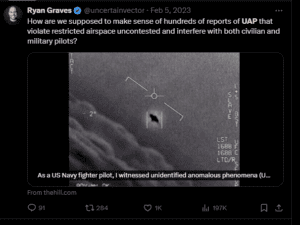 The “Go Fast” video, along with the “Gimbal” and “FLIR1 (Tic Tac)” videos, has played a major role in the increased scrutiny of UAPs over the past decade. The footage first surfaced in 2018 through The New York Times and To The Stars Academy of Arts & Science, an organization co-founded by former Blink-182 musician Tom DeLonge. At the time, the release of these videos marked an unprecedented public acknowledgment of military encounters with unidentified objects. Since then, congressional hearings and government reports have continued to fuel debates over the nature and origin of these phenomena.
The “Go Fast” video, along with the “Gimbal” and “FLIR1 (Tic Tac)” videos, has played a major role in the increased scrutiny of UAPs over the past decade. The footage first surfaced in 2018 through The New York Times and To The Stars Academy of Arts & Science, an organization co-founded by former Blink-182 musician Tom DeLonge. At the time, the release of these videos marked an unprecedented public acknowledgment of military encounters with unidentified objects. Since then, congressional hearings and government reports have continued to fuel debates over the nature and origin of these phenomena.
###
Document Archive
